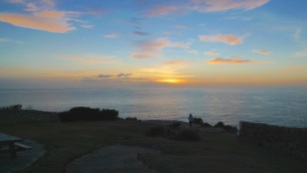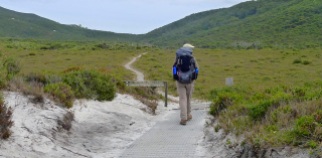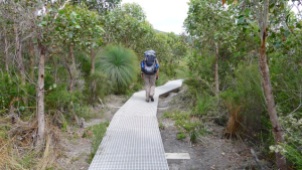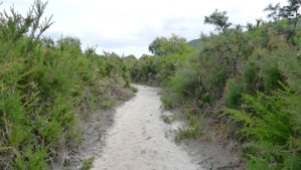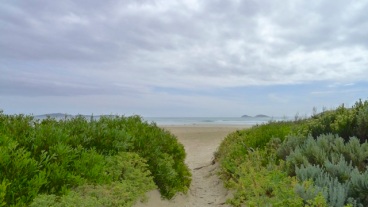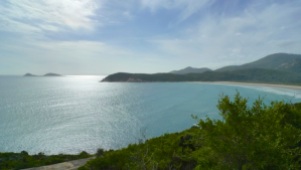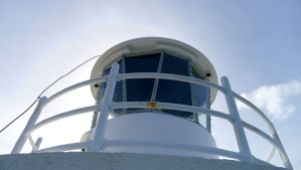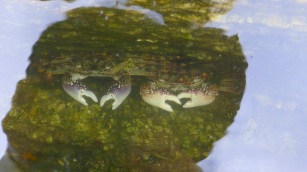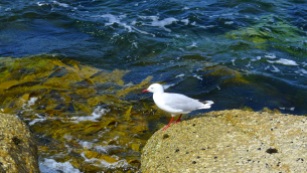Return to Tidal River
Via South East Walking Track – Waterloo Bay Walking Track – Oberon Bay Walking Track
Dawn was slightly cloudier, though just as magical, on our second and last morning at the lightstation. There was more activity in the cottage this morning compared to yesterday as all overnight guests were checking out today. We were aiming to be out on the track by 9am(ish) but I think we were beaten out the door by a couple of hours by some of last nights guests! Not that it’s a race; we were there to enjoy the experience after all.
In our tired state of arrival on Tuesday, two days before, we had considered taking the shortest route back out (i.e. back along Telegraph Track). Fortunately, the weather had cooled as predicted and after a day of rest we were re-evaluating our options for getting back to Tidal River. We decided to stick with the original plan of heading up the east side to Waterloo Bay, turning inland from there to Telegraph Track, and following that up and over Telegraph Saddle – an anticipated 24.1km.
We had taken advantage of the spare food draw to leave behind the rice & tuna (hopefully it finds its way into a hungry stomach or two!), which meant we were only carrying lunch and snacks for today (if you’re interested, see what food we took here). Thankfully our packs were now a kilo or three (in Stephen’s case) lighter. When I shouldered my pack and tightened the waist strap, it actually felt right!! Thank heavens for that, because I really wasn’t looking forward to another 20km+ walk with an uncomfortable pack.
Walking down the steep path to the lighthouse I was once again thankful that I don’t usually have issues with my knees. With a pack on there’s a bit more strain everywhere.
As we climbed the path up to the main (South East Walking) track we passed the first of three groups we’d see that morning. These young people were trooping down the path, once again looking like they’d been transported from a suburban park. One or two said ‘Hi’ as they passed, but it was the group leader at the end, a middle-aged bloke (possibly someone in the group’s dad?) whose comment surprised me.
“Gee, you took your packs?”
Well, we certainly weren’t going to leave them behind!
He was gone as soon as he’d said it, but it got me wondering – how many people realise that there’s accommodation at the lightstation?
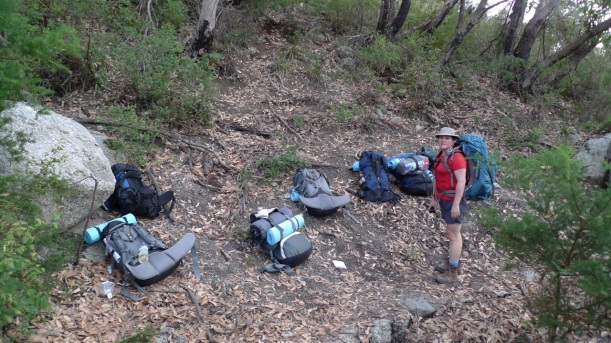
If you’re only visiting the lighthouse as an optional side trip, why bother taking your pack with you?
The South East Walking Track has much to recommend it. So much more pleasant walking than the Telegraph Track yesterday. Lovely path, trees, rocks, views…
Walking north towards Waterloo Bay there is a long steep-ish ridge to climb, but it is shaded and fortunately for us the group coming downhill didn’t bowl us over.
Occasionally you’ll find yourself up to your waist in brakenfern. And sometimes up to your chest. I hadn’t taken any precautions against leeches or ticks, but thankfully I didn’t pick any up. Whether it was because we weren’t the first walkers through this morning, or because the weather lately had been so dry that leeches were a bit scarce, or because there usually aren’t many along there, I’m not sure – just grateful, whatever the reason.
By now we had been passed by three groups heading south and an older couple hiking and camping independently – must have been a busy night at Little Waterloo Bay camping area last night!
From the highest point of the track it’s pretty much downhill all the way to Waterloo Bay.
We spotted two figures walking along the beach below and thought it could be Neal and Elle, who we knew were walking this way and had started out before us this morning, but we caught up with them before the bottom of the hill. Must have been another pair of hikers enjoying this magnificent part of the world.
Waterloo Bay is quite beautiful.
This time it was nice to have company while looking for the track leading off the beach. Stephen may have been pretty confident that it was 1km along, but after our Oberon Bay experience, I wasn’t taking anything for granted.

Waterloo Bay Walking Track entrance to the beach, about 1.2km north of track onto beach from lighthouse.
Once again it’s not obvious from a great distance, but unless there’s been a really high tide or stormy weather, it could be likely that there’s a lot of footprints around to lead you in the right direction. The clear giveaway here that this is the path you’re looking for is the large gap in the dunes and the mesh that’s been laid down to prevent erosion – more on that shortly.
Waterloo Bay Walking Track found, it was time for lunch. I was starting to get tired of salami, but our guest wasn’t getting fed, even if it did the ‘poor me, I’ve only got one leg’ trick.
Although Neal had very kindly offered to give us a lift from Telegraph Saddle (where they had parked their car) to Tidal River, we decided to push on ahead of them. Shouldering our packs we waved goodbye and set off.
I was expecting this track to be fairly similar to the one on the opposite side that joins Oberon Bay and Telegraph Track, except just over a kilometre longer. Maybe once it was, but currently it’s quite different because you’re not following a vehicle track (thank goodness for that!), there’s more change in elevation, and the vegetation is also much more varied. There are some stretches of sand (especially at the Telegraph Track end), but boardwalks and quite a bit of grid have been put in too. A lot of work has been done to limit erosion along here.
You start out in the swamp, but don’t worry – the boardwalk, though not as long as through Sealers Swamp, is (currently) in perfect condition. The grating also reappears periodically to protect parts of the track that have been more affected by erosion.
It’s not too long before the gentle rise gets steeper as you climb up the south side of the valley and pass below the Mussolini Rocks.
From there you can see the back of Mt Oberon and across to Oberon Bay.
Despite having walked along Telegraph Track just two days ago, we couldn’t spot exactly where it was from the Waterloo Walking Track until we were right back at Telegraph Junction.
There seem to be signs every which way you look at the junction. It’s not easy to explain, so I’ve made a mud map.
Here are un-cropped photos of the signs (A to D) at Telegraph Junction:
I’ve also summarised the information on the signs because at the time not all of them seemed to agree, and sometimes it’s not until I’ve got pen and paper in hand that I can get things straight in my own mind. It would seem that someone else could have used a bit of pen and paper at some point too…? Check out the Roaring Meg numbers.
Now that we were at, very literally, a cross roads once more, our next choice came down to the long, known way or the shorter, unknown, but probably harder way. In other words, back via Oberon Bay, or up and over Telegraph Saddle (via Oberon Carpark)? If we went up and over, the plan was for one person to stay with the packs at the top while the other person walked the final 3.5km back to Tidal River to get the car and come back to collect the other person and packs.
Despite today not being as hot as the first day, we were once again getting low-ish on water. Another steep hill climb really didn’t sound very appealing at all. We chose the known path via the beach – 11km vs 9.6km according to our SV Map or 10km according to Parks Victoria. (Whatever!)
The first section back to Oberon Beach is fairly unremarkable so we just tried to walk the sandy track as briskly as we could.
Eventually we made it to the beach. It was a very welcome sight. The compact, wet sand makes for easy walking for a kilometre to the northern end of the beach.
Having had a bit of a rest walking along the flat, it was time to climb again. On the plus side, the track around this headland isn’t particularly demanding, and there’s great views and a breeze to be enjoyed.
Climbing up the fine white sand dune to regain the path was tiring. There is a reason why surf lifesavers generally look so fit – sand and sea are not the easiest surfaces to propel yourself through!
The track around the headland past Norman Point climbs just as much as the previous headland, but this time it felt steeper. It was probably that I was just longing to reach the end and re-fill my water bottles. We were both quite tired and more than ready for a long icy drink by now.
Leaving beach views behind, the track heads inland then runs more or less parallel to the beach, back to Tidal River.
It had been a long walk, but we were finally back!
We’d made it! Unfortunately I don’t have a finish line photo. So here’s a wrap up instead.
Total walking time for ~25km was 7hr 15min but of that actual moving time was only 6hr 20min, according to my Garmin data.
As it was now about 5pm (or there abouts) it was well after closing time for both the Visitor Centre and the General Store. Checking in to report that we’d made it back safely would have to wait until tomorrow, but more importantly in the immediate present we’d have to wait until driving out of the park before getting Stephen the quick sugar hit (a soft drink) he was craving as much as I had been desperate for my effervescent powder at the end of the first day’s walk.
Plain water was going to have to do for now. Since Tidal River is primarily a camping site, finding tap water was not a problem. Knowing if it was safe to drink was a little trickier. There weren’t signs saying not to drink from taps around the place, but to be on the safe side I re-filled our bottles from one of the permanent dishwashing stations (one of the brick buildings around the camp site).
The drive out was easy as it wasn’t late enough for nocturnal/diurnal animals to start feeding by the side of the road and become a traffic hazard – although you should always drive cautiously through the park. It’s about a 30min drive from Tidal River to the park’s entrance in daylight, a bit longer at dusk and night time because you need to slow down to avoid hitting animals.
We had taken (but left in the car while we were out on our hike) pasta to cook for tonight’s dinner back at the studio cottage at Black Cockatoo, but thought we might find something better at Yanakie General Store. Indeed we did! Thursday night was fish’n’chip night! It was fresh and it was good. There were enough chips for probably 4 people, but they were excellent chips, and came with an equally generous tub of tartare sauce. Perfect after a hard day’s hike, and enjoyed as we watched the cows returned to the field after their evening’s milking.
Hike complete, the question is… would we do it again? Yes. Definitely.
Would we do it differently? If we had camping gear it would be nice to take the time to do a bigger loop as I think most hikers do, instead of rushing in and rushing out as we did. But next time, regardless of camping equipment status, we’re planning to go in winter (which will also be off-peak – assuming a stay at the cottages can be booked then) and park up at the saddle carpark to shorten the walking time and distance by half a dozen kilometres! Shorter daylight hours in which to complete the walk, more clothes to pack, but perhaps less chance of encountering snakes on Telegraph Track.
I still want to visit South Point.
But mostly I want to go back and watch the sunrise again in that most serene and beautiful of places.
See also:
Preparing for Wilsons Promontory Lightstation hike (hiking food, tips on what you will/won’t need to pack)
Wilsons Promontory Lightstation (Part 1) (walking to the lightstation from Tidal River via Oberon Bay Walking Track and Telegraph Track
Wilsons Promontory Lightstation (Part 2) – Lighthouse tour, accommodation options, exploring eastern landing
Wilsons Promontory Lightstation (Part 3) (Return to Tidal River via South East Walking Track / Waterloo Bay)
: )









